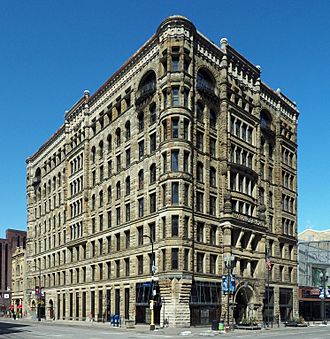Hennepin Center for the Arts facts for kids
Quick facts for kids Hennepin Center for the Arts |
|
|---|---|

The Hennepin Center for the Arts from the south
|
|
| General information | |
| Location | 528 Hennepin Avenue, Minneapolis, Minnesota |
|
Masonic Temple
|
|
| Area | Less than one acre |
| Built | 1888 |
| Architect | Long and Kees |
| Architectural style | Richardsonian Romanesque |
| NRHP reference No. | 75000987 |
| Added to NRHP | September 5, 1975 |
The Hennepin Center for the Arts (HCA) is an exciting place for arts in Minneapolis, Minnesota. It's located on Hennepin Avenue in a really old building. This building was first built way back in 1888.
It used to be a Masonic Temple, which was a meeting hall for a group called the Masons. In 1978, the building was bought and changed into the HCA. Today, it's owned by Artspace Projects, Inc.
Hennepin Center for the Arts Today
The HCA is home to more than 17 different performing and visual art groups. These groups use the building's eight floors for their work. On the eighth floor, you'll find the Illusion Theater. This theater hosts many shows put on by the art companies in the building.
Part of a Bigger Arts Center
The HCA is now part of a larger arts complex. This complex is called the Cowles Center for Dance and the Performing Arts. It used to be known as the Minnesota Shubert Performing Arts and Education Center.
The Cowles Center is made up of three buildings. It includes the HCA and the renovated Shubert Theatre building. The Shubert Theatre is now called the Goodale Theater. A new glass-walled area connects these two historic buildings. This area acts as a shared lobby for both. The Cowles Center had a big opening celebration from September 9 to 11, 2011.
A Historic Building
The building where the HCA is located has a special history. It was listed on the National Register of Historic Places in 1975. It was added to this list as the Masonic Temple.
It's important because of its amazing architecture. The building was designed by a famous local team called Long and Kees. They used a style called Richardsonian Romanesque. This style is known for its strong, stone look. The building is one of the last well-preserved examples of this style in Minneapolis.




